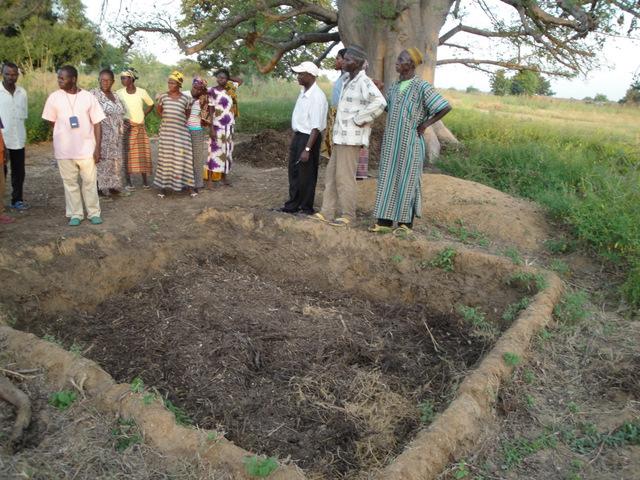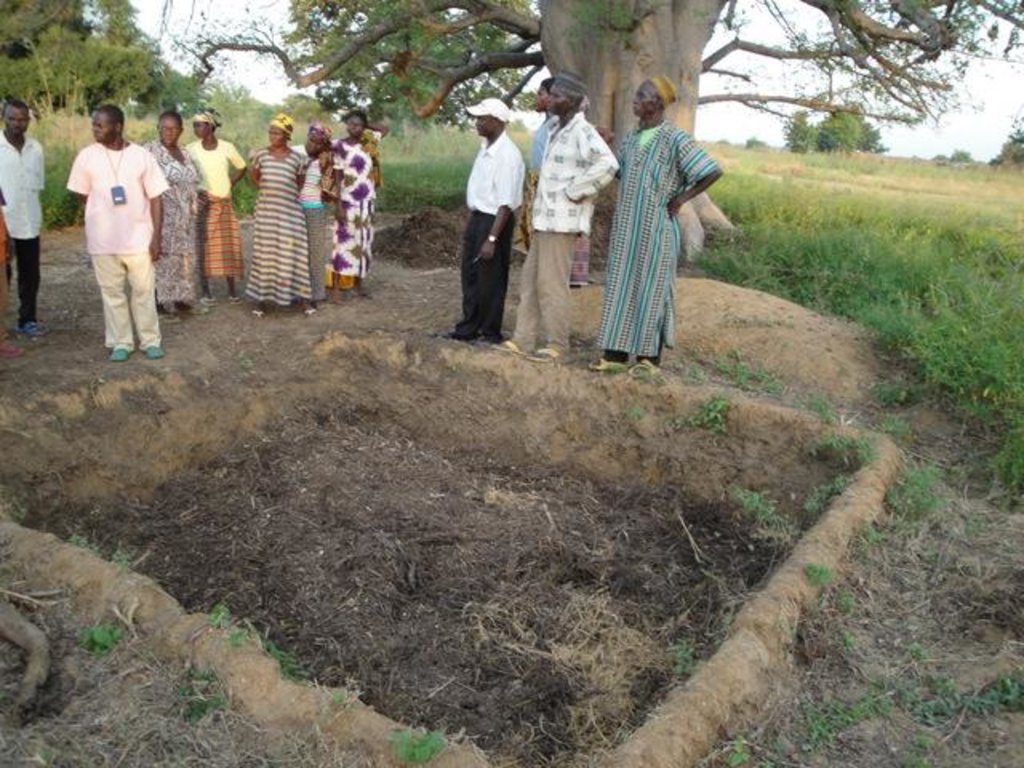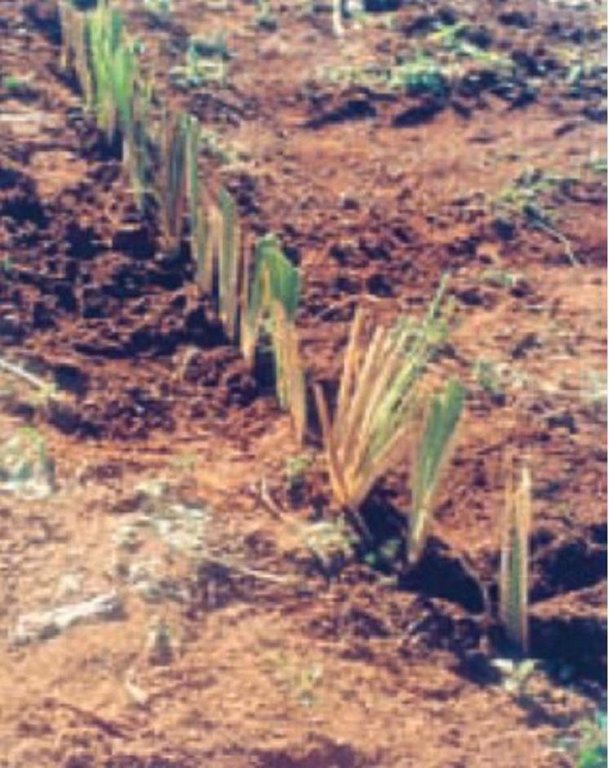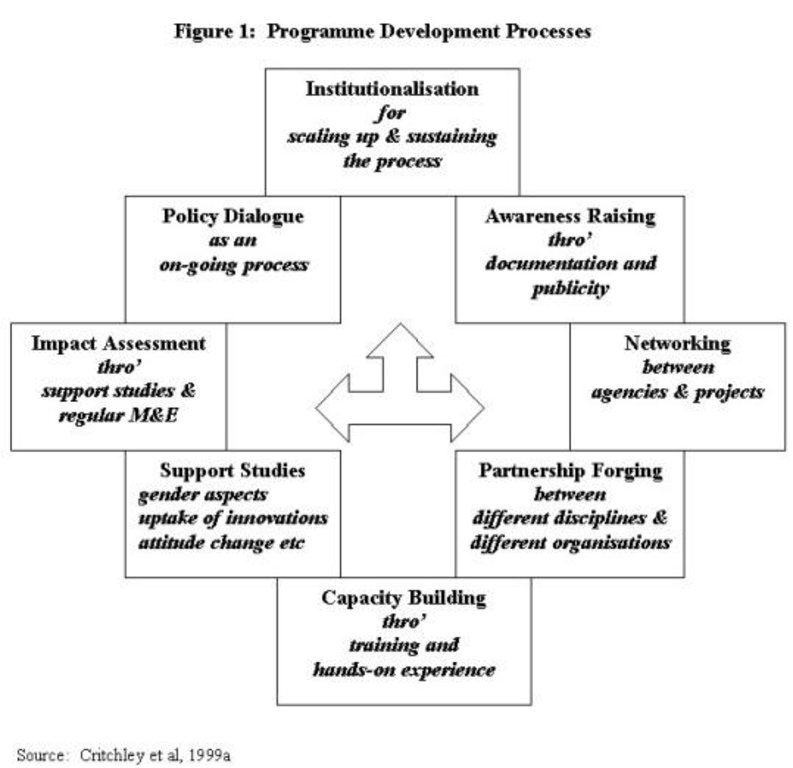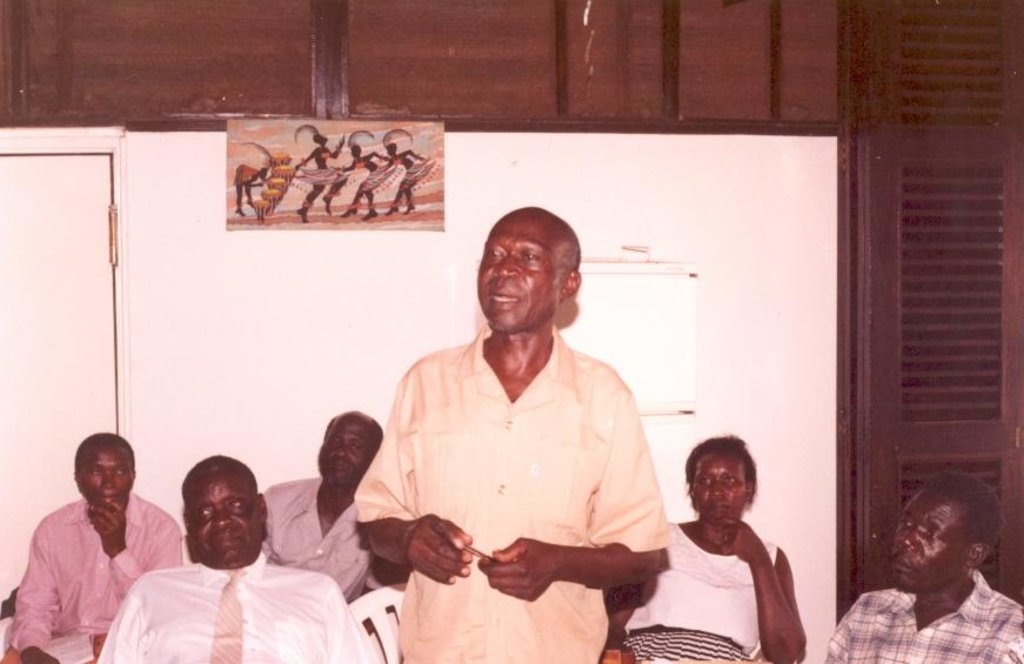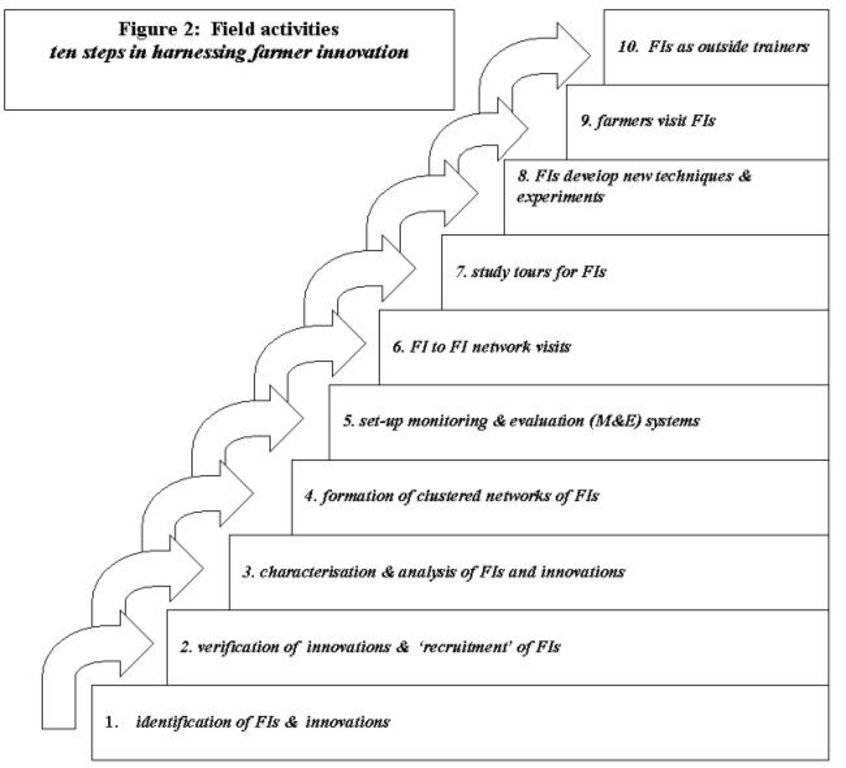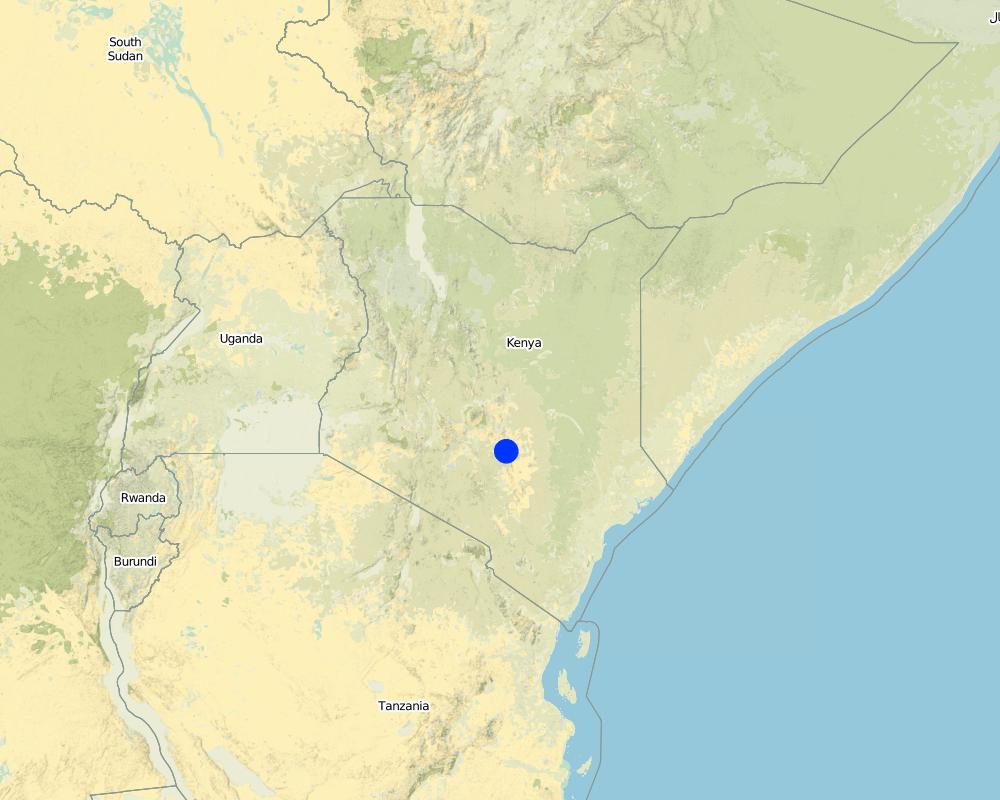Promoting Farmer Innovation [ប្រទេសកេនយ៉ា]
- ការបង្កើត៖
- បច្ចុប្បន្នភាព
- អ្នកចងក្រង៖ William Critchley
- អ្នកកែសម្រួល៖ –
- អ្នកត្រួតពិនិត្យ Fabian Ottiger
approaches_2412 - ប្រទេសកេនយ៉ា
ពិនិត្យមើលគ្រប់ផ្នែក
ពង្រីកមើលទាំងអស់ បង្រួមទាំងអស់1. ព័ត៌មានទូទៅ
1.2 ព័ត៌មានលម្អិតពីបុគ្គលសំខាន់ៗ និងស្ថាប័នដែលចូលរួមក្នុងការវាយតម្លៃ និងចងក្រងឯកសារនៃវិធីសាស្ត្រផ្សព្វផ្សាយ
អ្នកជំនាញឯកទេស SLM:
ឈ្មោះអង្គភាពមួយ (ច្រើន) ដែលបានចងក្រងឯកសារ/ វាយតម្លៃលើវិធីសាស្ត្រផ្សព្វផ្សាយ (បើទាក់ទង)
Food and Agriculture Organization of the United Nations (FAO) - ប្រទេសអ៊ីតាលី1.3 លក្ខខណ្ឌទាក់ទងទៅនឹងការប្រើប្រាស់ទិន្នន័យដែលបានចងក្រងតាមរយៈវ៉ូខេត
អ្នកចងក្រង និង(បុគ្គលសំខាន់ៗ)យល់ព្រមទទួលយកនូវលក្ខខណ្ឌនានាទាក់ទងទៅនឹងការប្រើប្រាស់ទិន្នន័យដែលបានចងក្រងតាមរយៈ វ៉ូខេត:
បាទ/ចា៎
2. ការពណ៌នាអំពីវិធីសាស្ត្រផ្សព្វផ្សាយ SLM
2.1 ពណ៌នាសង្ខេបខ្លីពីវិធីសាស្ត្រផ្សព្វផ្សាយ
The PFI approach seeks to build on technical initiatives - innovation in the local context - developed by farmers themselves in dry/marginal areas where the conventional approach of transfer of technology from research to extension agents and then on to farmers has so often failed.
2.2 ពណ៌នាលម្អិតពិវិធីសាស្ត្រផ្សព្វផ្សាយ
ពណ៌នាលម្អិតពិវិធីសាស្ត្រផ្សព្វផ្សាយ:
Aims / objectives: The objective of PFI is to stimulate technical innovation, in the field of land management, by farmers. The approach basically comprises indentifying, validating and documenting local innovations/initiatives. Simple monitoring and evaluation systems are set up amongst those innovative farmers who are willing to co-operate. Through contact with researchers, extra value is added to these techniques where possible.
Methods: Farmer innovators are brought together to share Ideas. Finally, best-bet technologies, in other words thos that are considered to be good enough to be sharedd, are disseminated through farmer-to-farmer extension. This takes two forms. First, farmers are brought to visit the innovators in their farms. Secondly, farmer innovators are used as teachers/trainers to visit groups of farmers - including FAO's farmer field schools in some cases. Only in this second form of extension is an allowance payable to the innovator. A ten-step field activity methodology has been developed.
Role of stakeholders: At programme level, there is capacity building of in-line extension and research staff, who are the main outside actors in the programme. In each of the countries the approach has been implemented through a government ministry and with NGOs in the field. The principle, and practice, is not to create seperate project enclaves, but to work through existing personnel, sharing buildings and vehicles that are already operational in the area. A programme development process methodological framework shows how the ultimate goal of institutionalisation can be achieved. PFI's first phase, completed in 2000, was financed by the Government of The Netherlands, through UNDP, and was active in Kenya, Tanzania and Uganda.
2.3 រូបភាពនៃវិធីសាស្ត្រផ្សព្វផ្សាយ
2.5 ប្រទេស/តំបន់/ទីតាំងកន្លែង ដែលវិធីសាស្ត្រផ្សព្វផ្សាយត្រូវបានអនុវត្តន៍
ប្រទេស:
ប្រទេសកេនយ៉ា
តំបន់/រដ្ឋ/ខេត្ត:
Mwingi District
Map
×2.6 កាលបរិច្ឆេទនៃការចាប់ផ្តើម និងបញ្ចប់នៃវិធីសាស្រ្តផ្សព្វផ្សាយនេះ
សូមបញ្ជាក់ឆ្នាំដែលបានបង្កើតឡើង:
1996
ឆ្នាំបញ្ចប់ (ប្រសិនបើវិធីសាស្ត្រផ្សព្វផ្សាយត្រូវបានឈប់ប្រើប្រាស់):
2000
2.7 ប្រភេទនៃវិធីសាស្ត្រផ្សព្វផ្សាយ
- ផ្អែកលើគម្រោង/កម្មវិធី
2.8 គោលបំណង/ទិសដៅសំខាន់នៃវិធីសាស្ត្រផ្សព្វផ្សាយ
The Approach focused mainly on SLM with other activities (better land husbandry practices (eg animal husbandry/ crop selection))
Improve rural livelihoods through an increase in the rate of diffusion and appropriate SLM/water harvesting technologies, promotion of farmer-farmer exchange, capacity building of farmers and supporting organisations, promotion of policy dialogue
The SLM Approach addressed the following problems: Poor supply of relevant recommendations from research for small-scale farmers in marginal areas, poor delivery of SLM technologies to farmers, lack of motivation of research and extension staff, isolation of promising innovative SLM ideas which address low crop yields, land degradation and poverty, lack of exchange of innovative knowledge.
2.9 លក្ខខណ្ឌអនុញ្ញាត ឬរារាំងការអនុវត្តន៍បច្ចេកទេសដែលស្ថិតនៅក្រោមវិធីសាស្រ្តផ្សព្វផ្សាយ
បរិបទនៃស្ថាប័ន
- រារាំង
lack of motivation of research and extension institutions
Treatment through the SLM Approach: bringing them together with farmer innovators
ក្របខណ្ឌច្បាប់ (សិទ្ធិកាន់កាប់ដីធ្លី កម្មសិទ្ធីប្រើប្រាស់ដីនិងទឹក)
- រារាំង
The existing land ownership, land use rights / water rights hindered a little the approach implementation access to land for women was a problem that inhibited women to innovate
ផ្សេងៗ
- រារាំង
spread of knowledge and ideas
Treatment through the SLM Approach: networking of farmers (+extension staff and researchers)
3. ការចូលរួម និងតួនាទីរបស់ភាគីពាក់ព័ន្ធ
3.1 អ្នកពាក់ព័ន្ធដែលបានចូលរួមក្នុងវិធីសាស្ត្រផ្សព្វផ្សាយ និងតួនាទីរបស់ពួកគេ
- អ្នកប្រើប្រាស់ដីក្នុងតំបន់/សហគមន៍
Existing groups of land users
Men tend to 'volunteer' themselves as innovators and to ignore their wives. This led to (1) gender studies and (2) gender sensitisation workshops to try to overcome the problem(s)
- រដ្ឋាភិបាលថ្នាក់ជាតិ (អ្នករៀបចំផែនការ អ្នកសម្រេចចិត្ត)
International specialists in collaboration with/ after discussions with national specialists and land users
- អង្គការអន្តរជាតិ
3.2 ការចូលរួមរបស់អ្នកប្រើប្រាស់ដីក្នុងតំបន់/ សហគមន៍ក្នុងតំបន់ក្នុងដំណាក់កាលផ្សេងគ្នានៃវិធីសាស្រ្តផ្សព្វផ្សាយ
| ការចូលរួមរបស់អ្នកប្រើប្រាស់ដីក្នុងតំបន់/សហគមន៍ក្នុងតំបន់ | សូមបញ្ជាក់នរណាត្រូវបានចូលរួម ព្រមទាំងពណ៌នាសកម្មភាពទាំងនោះ | |
|---|---|---|
| ការចាប់ផ្តើម/ការលើកទឹកចិត្ត | អសកម្ម | public meetings, interviews/questionnaires, workshops/seminars, rapid/participatory rural appraisal |
| ការរៀបចំផែនការ | អន្តរកម្ម | rapid/participatory rural appraisal, interviews/questionnaires, workshops/seminars, public meetings, |
| ការអនុវត្តន៍ | អន្តរកម្ម | Mainly: responsibility for minor steps; partly: responsibility for major steps |
| ការត្រួតពិនិត្យ និងវាយតម្លៃ | អន្តរកម្ម | Mainly: public meetings, measurements/observations; partly: workshop/seminars; |
| Research | អន្តរកម្ម | Mainly: public meetings, measurements/observations; partly: workshop/seminars; |
3.3 គំនូសបំព្រួញ (ប្រសិនបើមាន)
3.4 ការសម្រេចចិត្តលើការជ្រើសរើសបច្ចេកទេស SLM
សូមបញ្ជាក់តើអ្នកណាជាអ្នកបានសម្រេចចិត្តក្នុងការជ្រើសរើសបច្ចេកទេសដើម្បីយកមកអនុវត្តន៍:
- អ្នកប្រើប្រាស់ដី ដោយមានការគាំទ្រពីអ្នកជំនាញឯកទេស SLM
ចូរពន្យល់:
land user driven (bottom-up). farmers developed the technologies; field staff selected them
Decisions on the method of implementing the SLM Technology were made by mainly by land users supported by SLM specialists. land user driven (bottom-up).
4. ជំនួយបច្ចេកទេស ការកសាងសមត្ថភាព និងការគ្រប់គ្រងចំណេះដឹង
4.1 ការកសាងសមត្ថភាព/ បណ្តុះបណ្តាល
តើវគ្គបណ្តុះបណ្តាលបានផ្តល់ឱ្យអ្នកប្រើប្រាស់ដី/អ្នកពាក់ព័ន្ធផ្សេងៗទៀតដែរឬទេ?
បាទ/ចា៎
សូមបញ្ជាក់តើអ្នកណាត្រូវបានបណ្តុះបណ្តាល:
- អ្នកប្រើប្រាស់ដី
- SWC specialists, extensionists/trainer
ទម្រង់នៃការបណ្តុះបណ្តាល:
- ពីកសិករទីកសិករ
- ការប្រជុំជាសាធារណៈ
- វគ្គបណ្តុះបណ្តាល
ប្រធានបទបណ្តុះបណ្តាល:
1. Training in presentation skills for farmer innovators 2. Facilitation of field days where innovators/ extension staff could present jointly (so farmers trained thereby)
4.2 សេវាផ្តល់ប្រឹក្សាយោបល់
តើអ្នកប្រើប្រាស់ដីបានទទួលនូវសេវាផ្តល់ប្រឹក្សាដែរ ឬទេ?
បាទ/ចា៎
សូមបញ្ជាក់ប្រសិនបើសេវាកម្មប្រឹក្សាយោបល់ត្រូវបានផ្តល់ឱ្យ:
- នៅលើដីរបស់អ្នកប្រើប្រាស់ដី
ពណ៌នា/ពន្យល់:
Name of method used for advisory service: 'Farmer Innovation Approach'; Key elements: Identify Fis, Form networks of FIs groups which meet, Bring farmers to see 'best-bet' innovations; 1) Advisory service was carried out through: government's existing extension system, non-governmental agency 2) Advisory service was carried out through: government's existing extension system, non-governmental agency; Extension staff: mainly government employees
Advisory service is quite adequate to ensure the continuation of land conservation activities
4.3 ការពង្រឹងសមត្ថភាពស្ថាប័ន (ការអភិរឌ្ឍន៍អង្គភាព)
តើស្ថាប័នទាំងអស់ត្រូវបានបង្កើតឡើង ឬពង្រឹងសមត្ថភាពតាមរយៈវិធីសាស្ត្រផ្សព្វផ្សាយដែរ ឬទេ?
- បាទ/ច៎ា ជាមធ្យម
សូមបញ្ជាក់ថាតើស្ថាប័នត្រូវបានពង្រឹង ឬបង្កើតឡើងនៅត្រឹមកម្រិតណា(ច្រើន)?
- ថ្នាក់មូលដ្ឋាន
សូមបញ្ជាក់ប្រភេទនៃការគាំទ្រ:
- ការកសាងសមត្ថភាព/ បណ្តុះបណ្តាល
4.4 ការត្រួតពិនិត្យ និងវាយតម្លៃ
តើការត្រួតពិនិត្យ និងវាយតម្លៃគឺជាផ្នែកមួយនៃវិធីសាស្ត្រដែរឬទេ?
បាទ/ចា៎
មតិយោបល់:
bio-physical aspects were regular monitored
technical aspects were regular monitored
socio-cultural aspects were ad hoc monitored
economic / production aspects were regular monitored
area treated aspects were ad hoc monitored
no. of land users involved aspects were ad hoc monitored
There were few changes in the Approach as a result of monitoring and evaluation: e.g. Better integration with government services/ system for technical backstopping and extension
4.5 ការស្រាវជ្រាវ
តើការស្រាវជ្រាវ គឺជាផ្នែកមួយនៃវិធីសាស្រ្តដែរឬទេ?
បាទ/ចា៎
បញ្ជាក់ប្រធានបទ:
- បច្ចេកវិទ្យា
សូមផ្តល់ព័ត៌មានបន្ថែមទៀតឱ្យបានលម្អិត និងចង្អុលបង្ហាញនរណាដែលបានធ្វើការស្រាវជ្រាវ:
research was slow to begin activities in this phase but supposed to be a key pillar in this farmer/ research/ extension linkage
Research was carried out on-farm
5. ថវិកា និងសម្ភារៈឧបត្ថម្ភពីខាងក្រៅ
5.1 ថវិកាប្រចាំឆ្នាំសម្រាប់ផ្សព្វផ្សាយ SLM
ប្រសិនបើចំនួនពិតប្រាកដនៃថវិកាប្រចាំឆ្នាំមិនត្រូវបានដឹងច្បាស់ សូមប្រាប់ពីចន្លោះនៃថវិកានោះ:
- 100,000-1,000,000
មតិយោបល់ (ឧ. ប្រភពសំខាន់នៃមូលនិធិ/ម្ចាស់ជំនួយចំបង):
Approach costs were met by the following donors: international (Dutch Government): 60.0%; government (national): 20.0%; local community / land user(s) (-): 20.0%
5.3 សូមបញ្ជាក់ពីធាតុចូលត្រូវបានផ្តល់បដិភាគ (រួមទាំងកម្លាំងពលកម្ម)
- កសិកម្ម
| សូមបញ្ជាក់ ធាតុចូលណាខ្លះដែលបានផ្តល់បដិភាគ | កម្រិតទំហំប៉ុណ្ណា | សូមបញ្ជាក់ពីការបដិភាគ |
|---|---|---|
| គ្រាប់ពូជ | ផ្តល់ហិរញ្ញវត្ថុមួយផ្នែក | |
ប្រសិនបើកម្លាំងពលកម្មធ្វើដោយអ្នកប្រើប្រាស់ដី តើវាជាធាតុចូលដ៏សំខាន់មួយដែរ ឬទេ:
- ដោយស្ម័គ្រចិត្ត
5.4 ឥណទាន
តើឥណទានដែលបានផ្តល់នៅក្រោមវិធីសាស្ត្រផ្សព្វផ្សាយសម្រាប់សកម្មភាព SLM នេះយ៉ាងដូចម្តេច?
ទេ
6. ការវិភាគរកផលប៉ះពាល់ និងសេចក្តីសន្និដ្ឋាន
6.1 ផលប៉ះពាល់នៃវិធីសាស្ត្រផ្សព្វផ្សាយ
តើវិធីសាស្ត្រផ្សព្វផ្សាយជួយអ្នកប្រើប្រាស់ដីដើម្បីអនុវត្តន៍ និងថែទាំបច្ចេកទេស SLM?
- ទេ
- បាទ/ច៎ា បន្តិចបន្តួច
- បាទ/ច៎ា ជាមធ្យម
- បាទ/ច៎ា បានខ្លាំង
Innovative land husbandry technologies of other farmers
តើវិធីសាស្ត្រផ្សព្វផ្សាយបានឱ្យប្រសើរឡើងនូវបញ្ហាកាន់កាប់ដីធ្លី/សិទ្ធិអ្នកប្រើប្រាស់ដែលរារាំងដល់ការអនុវត្ត SLM?
- ទេ
- បាទ/ច៎ា បន្តិចបន្តួច
- បាទ/ច៎ា ជាមធ្យម
- បាទ/ច៎ា បានខ្លាំង
Gender sensitisation training may have helped The problem is unlikely to be overcome in the near future.
Did other land users / projects adopt the Approach?
- ទេ
- បាទ/ច៎ា បន្តិចបន្តួច
- បាទ/ច៎ា ជាមធ្យម
- បាទ/ច៎ា បានខ្លាំង
1. GTZ in Kenya are adopting the PFI approach widely; 2. FAO's farmer field schools are joining hands with PFI in Kenya 3. INADES Tanzania adopted the approach 4. Several organisations in Uganda have expressed an interest
- ទេ
- បាទ/ច៎ា បន្តិចបន្តួច
- បាទ/ច៎ា ជាមធ្យម
- បាទ/ច៎ា បានខ្លាំង
- ទេ
- បាទ/ច៎ា បន្តិចបន្តួច
- បាទ/ច៎ា ជាមធ្យម
- បាទ/ច៎ា បានខ្លាំង
6.3 សកម្មភាពផ្សព្វផ្សាយដែលប្រកបដោយចីរភាព
តើអ្នកប្រើប្រាស់ដីអាចធ្វើឱ្យមានចីរភាពនូវអ្វីដែលត្រូវបានអនុវត្តន៍តាមរយៈវិធីសាស្ត្រផ្សព្វផ្សាយដែរឬទេ(ដោយពុំមានការគាំទ្រពីអ្នកខាងក្រៅ)?
- មិនប្រាកដ
ប្រសិន ទេ ឬមិនប្រាកដសូមបញ្ជាក់ និងពន្យល់:
There may be some groups of farmers who will continue to meet and exchange ideas but this approach basically depends on a continuation (long term) of the farmer/ extension/ research interaction
6.4 ភាពខ្លាំង/ គុណសម្បត្តិនៃវិធីសាស្ត្រផ្សព្វផ្សាយ
| ភាពខ្លាំង/ គុណសម្បត្តិ/ ឱកាស ទស្សនៈរបស់អ្នកប្រើប្រាស់ដី |
|---|
| Gives them confidence |
| Offers them new and viable ideas from their peers |
| ភាពខ្លាំង/ គុណសម្បត្តិ/ ឱកាស ទស្សនៈរបស់បុគ្គលសំខាន់ៗ |
|---|
| Builds on local ideas (How to sustain/ enhance this strength: institutionalise the approach!) |
| Revitalises the extension service |
| Is attractive at all levels |
6.5 ភាពខ្សោយ/ គុណវិបត្តិនៃវិធីសាស្ត្រ និងរកដំណោះស្រាយ
| ភាពខ្សោយ/ គុណវិបត្តិ/ ហានិភ័យ ទស្សនៈរបស់អ្នកប្រើប្រាស់ដី | តើបច្ចេកទេសទាំងនោះបានដោះស្រាយបញ្ហាដូចម្តេច? |
|---|---|
| Research reluctant to respond to farmers' agenda | effort to convince researchers of benefits of joint research with farmers. |
| ភាពខ្សោយ/ គុណវិបត្តិ/ ហានិភ័យក្នុងទស្សនៈរបស់បុគ្គលសំខាន់ៗ | តើបច្ចេកទេសទាំងនោះបានដោះស្រាយបញ្ហាដូចម្តេច? |
|---|---|
| Depends on individual flexibility and commitment, does not follow the conventional institutional chain of command | training in skills and methodologies. |
| Sometimes confers too much prestige on a particular group of favoured farmers | rotate farmers who are the focus of attention. |
7. ឯកសារយោង និងវេបសាយ
7.1 វិធីសាស្ត្រ/ ប្រភពនៃព័ត៌មាន
- តាមការចុះទីវាល ការស្រាវជ្រាវនៅទីវាល
- ការសម្ភាសន៍ជាមួយអ្នកប្រើប្រាស់ដី
7.2 ឯកសារយោងដែលបានចេញផ្សាយ
ចំណងជើង អ្នកនិពន្ធ ឆ្នាំ ISBN:
Promoting Farmer Innovation (1999) Critchley et alVideo (same name)
មានប្រភពមកពីណា? ថ្លៃដើមប៉ុន្មាន?
RELMA, Nairobiditto
ការតភ្ជាប់ និងម៉ូឌុល
ពង្រីកមើលទាំងអស់ បង្រួមទាំងអស់ការតភ្ជាប់
គ្មានការតភ្ជាប់
ម៉ូឌុល
គ្មានម៉ូឌុល


